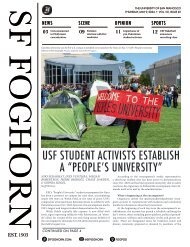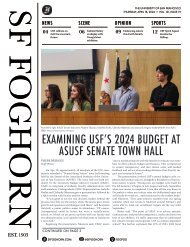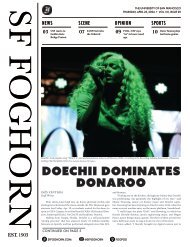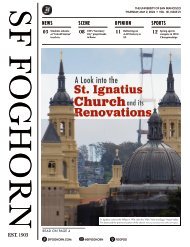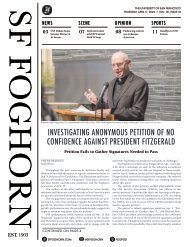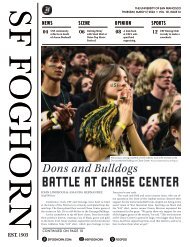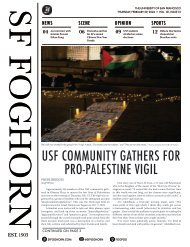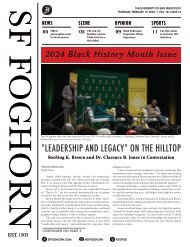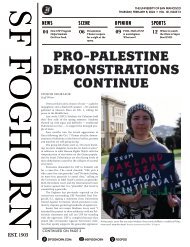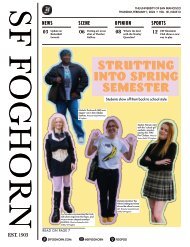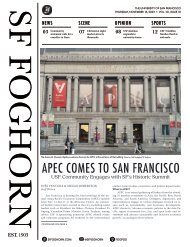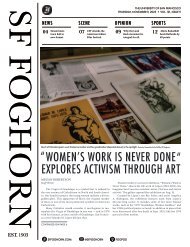VOL 119, Issue 7—Oct. 28, 2021
Create successful ePaper yourself
Turn your PDF publications into a flip-book with our unique Google optimized e-Paper software.
08 09<br />
THURSDAY<br />
OCT. <strong>28</strong>,<br />
<strong>2021</strong><br />
SCENE<br />
BEFORE<br />
AFTER<br />
WHO HASN’T BEEN AT THE TABLE?<br />
New Monuments Taskforce led by women of color<br />
re-evaluates 83 city monuments and the racist history<br />
they symbolize in The Relic Report<br />
In 2019, the statue of Christopher Columbus at Coit Tower was<br />
vandalized in red paint to symbolize spilt blood and then restored<br />
at the price of $70,000, only to be removed by the San Francisco<br />
Art Commission on June 18, 2020. The images show the view of<br />
the tower before and after the statue’s removal. PHOTOS COUR-<br />
TESY OF /WIKIMEDIA COMMONS<br />
SARA AHMED<br />
Staff Writer<br />
Prior to last summer’s social justice reckoning, the<br />
historical context behind Bay Area monuments were<br />
largely unrecognized. The national shift in consciousness<br />
regarding racial injustice in the United States<br />
sparked a wave of public conversation about the truths<br />
of these monuments.<br />
The Relic Report, a record evaluating the city’s<br />
monuments and their racially motivated and colonial<br />
values, was given a formal presentation Oct. 20. The<br />
event was hosted by Litquake, San Francisco’s literary<br />
festival, at the California Historical Society. It<br />
was co-presented by the New Monuments Taskforce<br />
(NMT) and Goethe-Institut SF and was led by the<br />
NMT’s Artistic Director Cheyenne Concepcion and<br />
Development Director Anna Lisa Escobedo.<br />
The NMT is a newly established group of artists<br />
and cultural workers who have taken on the responsibility<br />
of designing and developing new monuments in<br />
the Bay Area. However, before these new developments<br />
can occur, the NMT must evaluate the outcomes of<br />
The Relic Report and surveys with SF residents. The<br />
taskforce’s first initiative, as stated in the NMT report,<br />
was to “broaden understanding of our inherited monuments<br />
and memorials...and create space for critical<br />
conversations.”<br />
Concepcion, a multidisciplinary artist, SF activist,<br />
and author of The Relic Report, said that her joint interest<br />
in art and cities led her to the idea of monument<br />
examination. “What really got me interested in them<br />
was growing up in San Diego, and being right at the<br />
border because the most interesting thing about San<br />
Diego is that it’s half the city and half Tijuana,” said<br />
Concepcion. She explained that living in San Diego<br />
caused her to develop an interest in border urbanism.<br />
The border wall was the main influence in her love<br />
of monuments. “The thing that brought me to monuments<br />
is the wall, because I feel like the wall is such<br />
a monument. Things pass it every day: it’s completely<br />
arbitrary and yet it’s a symbol,” Concepcion said.<br />
The NMT categorized the monuments they evaluated<br />
into different categories. The first was called “The<br />
Boys Club”: a collection consisting of 53 memorialized<br />
men and three women. The NMT stated that many of<br />
the monuments are for “SF government bureaucrats<br />
and national heroes.” Of the 56 statues, only one memorialized<br />
a Black man (Mayor Willie Brown) and<br />
three memorialized women, revealing an imbalance in<br />
representation.<br />
The next category titled “The OGs” or “The Original<br />
Gentrifiers” consists of 15 monuments of notorious<br />
male figures in the colonialism and settlement of the<br />
United States. The collection begins with figures from<br />
the early Spanish expeditions in 1770, the Pioneers 150<br />
years after, and American-Dreamers: wealthy, white<br />
landowners who possessed power in SF. “A former<br />
mayor, James D. Phelan, is responsible for quite a few<br />
of the monuments in the civic collection today,” the<br />
NMT stated in the report. They went on to describe<br />
how Phelan had run for Senate on the campaign, “Keep<br />
California White.” Toler Hall on USF’s main campus<br />
was previously named after Phelan, but the building<br />
was renamed after Burl Toler, the co-captain of USF's<br />
famous 1951 football team and the first African American<br />
official in a major American professional sports<br />
league, in the wake of student action in 2017. “[Phelan’s]<br />
visions for San Francisco were grand… and they<br />
built monuments only for wealthy, white people,” the<br />
NMT concluded.<br />
The report included more categories of monuments<br />
throughout its account, all of which were rooted<br />
in misogyny, racism, exclusivity, and ultimately, white<br />
supremacy. As part of their initiative, Concepcion and<br />
the NMT surveyed Bay Area residents and collected<br />
their responses regarding the monumental relic collection.<br />
One resident stated that “the monuments only<br />
honor achievements of white males and reflect a certain<br />
hierarchy of who and what deserves to be honored<br />
by the collective.” Another stated, “My relationship to<br />
monuments is one of fear and or disgust. I want monuments<br />
who wouldn’t spit on me as I pass them.”<br />
Many of the responses the NMT received were<br />
veracious critiques of the monuments, with some even<br />
calling for the termination of the representations of<br />
white supremacist figures such as Christopher Columbus<br />
or King Carlos III, two colonizers who directly<br />
instituted and engaged in the genocide of Indigenous<br />
people in the Americas. On June 18, 2020, SF residents’<br />
disapproval and vandalization of colonial monuments<br />
led to the removal of a statue of Christopher Columbus<br />
at Coit Tower that had been installed in 1957.<br />
Towards the end of the event, Concepcion reflected<br />
on her time as a leader of the NMT and The Relic<br />
Report, and the role her identity played in its conception.<br />
“In almost every other avenue of life it’s been a<br />
hindrance to be a woman of color, or at least you feel<br />
the weight of that,” Concepcion said. She continued to<br />
emphasize how her identity as a woman of color became<br />
a strength while conducting The Relic Report.<br />
“The fact that I'm telling you how I see the world, and<br />
other people resonate with it, it’s like this is really what<br />
our monuments are saying to us.”<br />
Concepcion said she realized that although it’s difficult<br />
to feel seen and represented, experiences can never<br />
be “wrong,” and are valid despite any lack of external<br />
validation. “You can own a hundred percent of that and<br />
fight on it,” said Concepcion. “That is a strength that<br />
women of color have and I've learned to live in.”<br />
Concepcion mentioned that this lesson was new<br />
to her and connected it to her work with monuments.<br />
“What I experienced from 2020 is that now is the time<br />
to take up space and be unapologetic and live in your<br />
experience because no one can ever take that away from<br />
you. I always come from a very personal place when it<br />
comes to monuments because I think that I'm entitled<br />
to that and I'm gonna fight for that opinion to be heard<br />
too.”<br />
For more insight and a deeper look into The Relic Report,<br />
visit the website at newmonumentstaskforce.org and<br />
IG @newmonumentstaskforce.<br />
HOW USF’S COMMUNITY HELPED ME TAKE<br />
PRIDE IN MY FILIPINA IDENTITY<br />
JADE PEÑAFORT is a<br />
senior sociology major.<br />
Before October<br />
ends, I want to recognize<br />
Filipino American<br />
History Month, which<br />
celebrates the accomplishments,<br />
history, and<br />
legacy of Filipinos in<br />
the United States. But<br />
first, it’s important to<br />
acknowledge colonialism<br />
and the effect it still<br />
has on our people today.<br />
During the Spanish colonial<br />
era, Filipinos were<br />
stripped of their language,<br />
traditions, and<br />
identities. Years later, under U.S. imperialism, Filipinos<br />
became a laundry list for Uncle Sam to exploit<br />
as the demand for cheap labor increased. Because<br />
of this, Filipinos eventually came to make up the<br />
third-largest Asian American population in the country.<br />
Despite having widespread Filipinx communities<br />
throughout the states, there is still a large lack of representation<br />
in what it means to be Asian American.<br />
As a child, I was always aware that I came<br />
from a Filipino background. Both my parents were<br />
born in Quezon City and came to California as teenagers.<br />
I knew a good amount of Filipino dishes and<br />
could sing a few Filipino songs. I knew that I was<br />
Filipino, but it would be years before I understood<br />
what it actually meant to be a Filipina woman.<br />
In elementary and middle school, I was always<br />
embarrassed to bring food from home because it<br />
smelled different. I hated my last name because it<br />
PHOTOS BY JADE PEÑAFORT/SAN FRANCISCO FOGHORN<br />
didn’t fit in among my nonethnic classmates. I was<br />
even taught to pinch my nose when I was younger<br />
so that it wouldn’t be as flat. I learned from a very<br />
young age that being a person of color in the United<br />
States was deemed undesirable. I tried so carefully to<br />
distance myself from my Filipina identity because I<br />
was always surrounded by my white friends.<br />
Attending predominantly white schools in Redwood<br />
City my whole life made me realize how much<br />
I wanted to conform to white culture. I couldn’t comprehend<br />
that by ignoring my culture, I was erasing a<br />
part of myself that helped me identify with my roots<br />
and why I am the way I am.<br />
It wasn’t until college that I began to interact with<br />
and embrace my Filipina identity. In Professor Evelyn<br />
Rodriguez’s class, Filipinx for Black Lives, I learned to<br />
embrace the true history of Filipinos outside of the<br />
biases of Eurocentric ideology. We explored our own<br />
family trees and the traditions we may or may not<br />
continue to uphold in the states. Furthermore, we<br />
learned about our roles as allies and where we stand<br />
as people of color under white supremacy, and how<br />
we are linked to other marginalized communities.<br />
I was able to immerse myself in communities<br />
that understand my culture and upbringing. I’ve<br />
learned how important it is to surround myself with<br />
people who recognize who I am, where I come from,<br />
and the things I am capable of. The small community<br />
we built taught me to feel empowered by my culture<br />
and have pride in the stories and traditions that<br />
shape my identity. I was even taught to appreciate the<br />
uniqueness of my last name and the importance of<br />
pronouncing a Spanish name correctly.<br />
In Rabbi Camille Angel’s class, Queering Religion,<br />
I learned what it meant to be a woman and a<br />
sister and how I can use my privilege to uplift those<br />
around me. In Professor Marco Durazo’s class, Latinx<br />
& Chicanx Culture and Society, I am learning about<br />
the experiences we share with other ethnic groups under<br />
the system of white supremacy.<br />
In each of these classes, I met amazing people<br />
and was able to immerse myself in a culture that<br />
wasn’t present in my youth. We understood each others’<br />
struggles and pressures to assimilate to white culture<br />
as a people of color. We were able to debunk the<br />
myths that prevented us from fully accepting our Filipino<br />
identities and allowed us to create a safe space<br />
for learning, experimentation, and exploration.<br />
Navigating our identities is never easy. It takes<br />
personal effort to really learn about your background<br />
and heritage. To me, being Filipina means carrying<br />
on the stories and traditions that have been passed<br />
on throughout our history. It means carrying myself<br />
with confidence and resilience, the skills that our ancestors<br />
carried with them. It means decolonizing my<br />
mind, unlearning history, and reclaiming my Filipino<br />
roots. It means sharing perspectives and forming a<br />
deeper understanding of your place in the world as a<br />
Filipinx individual in a way that makes sense to you.<br />
As this month comes to an end, it’s important<br />
to acknowledge your family roots and the personal<br />
narratives that don’t get to be heard. It’s important<br />
to take pride in your family name, the shape of your<br />
nose, or the smell of a yummy traditional dish. For<br />
centuries, Filipinos have been stripped of their ability<br />
to create their own narratives. As the younger generation,<br />
it’s our responsibility to preserve the narratives<br />
of our ancestors and those to come.<br />
OPINION




